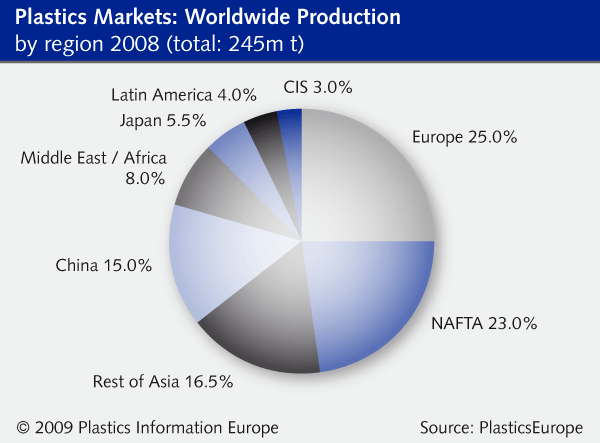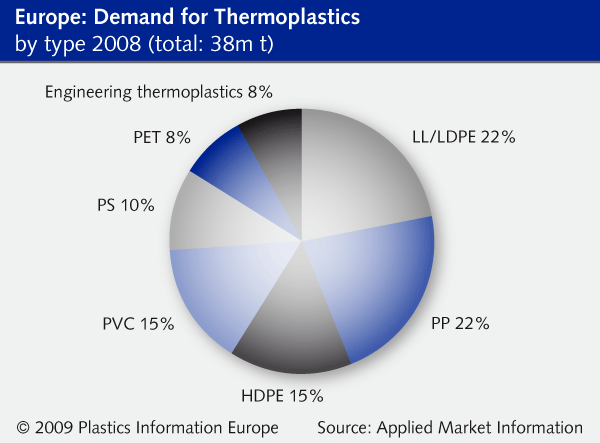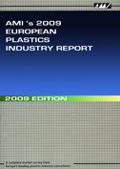PLASTICS MARKETS
Global production decline in 2008 / Dramatic drop in sales / Slump in European polymer consumption / Packaging and medicinal sector perform relatively well / First signs of a recovery
The economic downturn that began with the global financial crisis last year and later turned into a full-blown recession has left its mark indelibly on the world’s plastic industry. While the impact of the crisis on individual countries and market segments has been well documented, two of the latest reports quantify its effects on the global plastics economy.
“Compelling Facts about Plastics 2008”, compiled by PlasticsEurope (www.plasticseurope.org), the European Plastics Converters Association (EuPC; www.eupc.org) and the European Association of Plastics Recycling and Recovery (EPRO; www.epro-plasticsrecycling.org), focuses on European plastics production, consumption and recycling. Its figures show that global plastics production (including thermoplastics, polyurethanes, thermosets, elastomers, coatings, sealants and PP fibres) dropped by 6% in 2008 – from a record 260m t in 2007 – to some 245m t.
While markets were still relatively stable in the first six months of 2008, the economic downturn in Q3 and Q4 sent sales plummeting across the entire plastics industry. A sector spoilt by 34 years of successive growth was forced to contend with a global recession. Despite the setbacks, however, Europe remains the world’s most important plastics producing region, accounting for 25% of global output of around 60m t in 2008 – slightly ahead of the NAFTA region, which produces some 23% of all polymer materials.
“Compelling Facts about Plastics 2008”, compiled by PlasticsEurope (www.plasticseurope.org), the European Plastics Converters Association (EuPC; www.eupc.org) and the European Association of Plastics Recycling and Recovery (EPRO; www.epro-plasticsrecycling.org), focuses on European plastics production, consumption and recycling. Its figures show that global plastics production (including thermoplastics, polyurethanes, thermosets, elastomers, coatings, sealants and PP fibres) dropped by 6% in 2008 – from a record 260m t in 2007 – to some 245m t.
While markets were still relatively stable in the first six months of 2008, the economic downturn in Q3 and Q4 sent sales plummeting across the entire plastics industry. A sector spoilt by 34 years of successive growth was forced to contend with a global recession. Despite the setbacks, however, Europe remains the world’s most important plastics producing region, accounting for 25% of global output of around 60m t in 2008 – slightly ahead of the NAFTA region, which produces some 23% of all polymer materials.
 | |
The volume of plastics processed in Europe underwent a significant downturn in 2008, PlasticsEurope says. At the same time, consumption fell by 7.5% to 48.5m t. This shows just how much the entire plastics industry has been affected by the global crisis, says Wilfried Haensel, the association’s executive director. Despite “early signs,” he acknowledges that recovery will be some time in coming. To ensure both competitiveness and jobs, Haensel has urged the political sector not to place undue strains on the industry at present.
“Compelling Facts about Plastics” also offers detailed insights into the lifecycle of plastics in Europe. In, 2008, for example, the European plastics recycling ratio stood at 51.3% – an increase of 1.3% over 2007. Progress differed from country to country, with seven EU member states, along with Norway and Switzerland, achieving recycling rates of more than 80%. Germany, which recovers and recycles more than 90% of its post-consumer plastics waste, ranks third on the list of countries with the most successful recycling schemes and among the four that are close to meeting the European plastics industry’s goal of diverting waste streams from landfills.
European plastics consumption declining
In another report, British market research group Applied Market Information (AMI, Bristol / UK; www.amiplastics.com) has attempted to quantify the slump in Europe’s plastics market in 2008. “Not since the early 1980s has the plastics industry in Europe experienced such difficult market conditions as seen in 2008,” AMI says in its “2009 European Plastics Industry Report”. Demand for thermoplastics sank to 38m t in 2008, an 8% decrease against 2007. Against this background, the researchers forecast that the current crisis will lead to noticeable consolidation within the industry.
 | |
AMI notes that demand for thermoplastics began declining in the first six months of 2008, when concerns about the banks’ liquidity first surfaced. Although record polymer prices already were pushing plastics processors farther into a corner, many companies were surprised by the severity of the downturn. In the final quarter of 2008, polymer throughput decreased by an average of 20-25%.
PVC particularly hard hit by the crisis
Reduced consumption levels affected all thermoplastics, applications and markets, with varying degrees of severity. While several packaging, medicine and hygiene applications did relatively well, all products for the construction or the automotive industries took a serious hammering. The decline was relatively small for PET, thanks mainly to its use in the packaging sector. Consumption of polyolefins was 8 to 10% worse than in 2007 – due mainly to poor demand from the construction market. PVC fared worst in the downturn, with a market contraction of more than 11%.
Consumption of technical thermoplastics, where growth rates were about double those of standard thermoplastics over the past five years, receded by 7% in 2008. Due to its strong dependence on the automotive and the electrical industries, this plastics market segment probably will remain weak in 2009. A recovery is not expected before 2010.
The dwindling demand for thermoplastics is being most vividly felt in western Europe, particularly in the UK, Italy and Spain. Here, demand dropped by double-digit figures last year. Germany’s plastics processing industry was least affected by the downturn. According to AMI, the decline in central and eastern European markets only began at the end of 2008. However, demand in this region reached historically low levels in Q1 2009.
Consumption of technical thermoplastics, where growth rates were about double those of standard thermoplastics over the past five years, receded by 7% in 2008. Due to its strong dependence on the automotive and the electrical industries, this plastics market segment probably will remain weak in 2009. A recovery is not expected before 2010.
The dwindling demand for thermoplastics is being most vividly felt in western Europe, particularly in the UK, Italy and Spain. Here, demand dropped by double-digit figures last year. Germany’s plastics processing industry was least affected by the downturn. According to AMI, the decline in central and eastern European markets only began at the end of 2008. However, demand in this region reached historically low levels in Q1 2009.
Downturn gathers momentum in H1 2009
With GDP in the EU-27 countries predicted to decline by 4% in 2009, AMI does not expect a quick recovery for the plastics industry. According to PlasticsEurope, production and consumption decreased by 20% year-on-year throughout Europe in H1. Although signs of a slight improvement are increasing, the European plastics processing industry is forecast to contract by an additional 3-4% during 2009. Citing “too fragile” markets, EuPC has urged polymer producers to exercise restraint on further price hikes – see Plasteurope.com of 19.10.2009.
As plastics processing is a mature market in Europe, AMI believes its success will be tied increasingly to economic developments in future. Based on predictions of economic improvement in 2010, the research group expects thermoplastics consumption to grow markedly in the period 2010-2013. Packaging markets are thought likely to reap the most benefits, especially in central and eastern Europe. Medical plastics applications are also predicted to increase their market share. To secure their long-term survival, European converters will have to be increasingly innovative, more technology oriented and more cost efficient, while keeping debt under control, AMI says.
e-Service:
PlasticsEurope: “The Compelling Facts about Plastics 2009” as a PDF document (18,519 KB)
As plastics processing is a mature market in Europe, AMI believes its success will be tied increasingly to economic developments in future. Based on predictions of economic improvement in 2010, the research group expects thermoplastics consumption to grow markedly in the period 2010-2013. Packaging markets are thought likely to reap the most benefits, especially in central and eastern Europe. Medical plastics applications are also predicted to increase their market share. To secure their long-term survival, European converters will have to be increasingly innovative, more technology oriented and more cost efficient, while keeping debt under control, AMI says.
e-Service:
PlasticsEurope: “The Compelling Facts about Plastics 2009” as a PDF document (18,519 KB)
 |
Book Service:
AMI report “AMI’s 2009 Plastics Industry Report”, 10th edition, 2009, 289 pages, bound: EUR 555 + VAT, PIE No: 47371.
AMI report “AMI’s 2009 Plastics Industry Report”, 10th edition, 2009, 289 pages, bound: EUR 555 + VAT, PIE No: 47371.
02.11.2009 Plasteurope.com [214609]
Published on 02.11.2009

 German version of this article...
German version of this article...